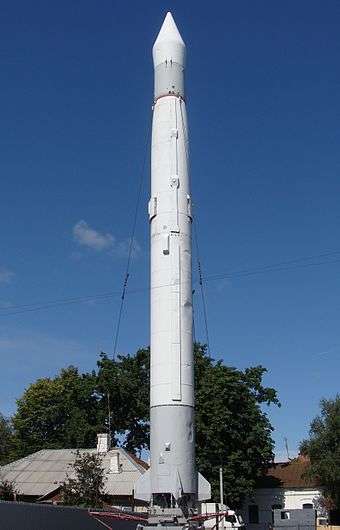SS-3 Shyster
| R-5 | |
|---|---|
|
R-5 on display at the Zhytomyr Korolyov Museum | |
| Type | Theatre ballistic missile |
| Place of origin | USSR |
| Service history | |
| In service | 1956-1967 |
| Specifications | |
| Warhead | 60 \ 80 kt , 300 kt , 1 Mt (or more) thermonuclear warhead |
|
| |
| Propellant | Liquid |
Operational range | 1,200 km (750 mi) |
Guidance system | inertial guidance plus radio command guidance |
The R-5 Pobeda[1] (Побе́да, "Victory") was a theatre ballistic missile developed by the Soviet Union during the Cold War. The R-5M version was assigned the NATO reporting name SS-3 Shyster and carried the GRAU index 8K51.
The R-5 was originally a development of OKB-1 as a single-stage missile with a detachable warhead reentry vehicle. The R-5M was a nuclear armed missile – the first nuclear missile to be deployed by the Soviet Union – with greater payload and weight but better reliability than its predecessor. The R-5M gave the Soviet Union the ability to target many strategic targets in Europe. The R-5M entered service on 21 May 1956 (retired in 1967), and in 1959 was installed at Vogelsang, Zehdenick and Fürstenberg/Havel in East Germany - the first Soviet nuclear missile bases outside of the USSR.[2]
R-5 was additionally an oft-reported alternate designation for the Kaliningrad K-5 air-to-air missile.
Specification
- Propellant liquid
- Range 1,200 kilometres (750 mi)
- Period of storage after fueling 1 hour[3]
- Time of preparation 2.5 hours
- Guidance: inertial guidance plus radio command guidance
- Warhead and Yield 60 \ 80 kt, 300 kt, 1 Mt (or more) thermonuclear warhead
Operators
See also
References
External links
| Wikimedia Commons has media related to R-5 (rocket). |
